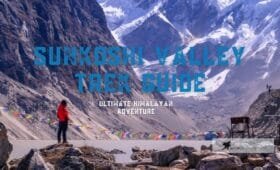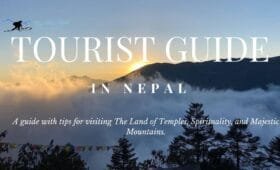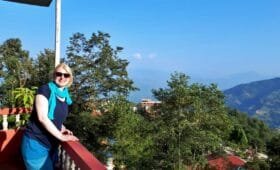The Solukhumbu to Namche Trek stands out as a lesser-crowded yet advantageous overland route to the heart of Everest country. Although the typical traveler might opt for a flight directly to Lukla, Solukhumbu to Namche Trek reintroduces the old-school thrill of walking through terraced farmland, traditional villages, and scenic ridges before finally arriving at Namche Bazaar—the bustling Sherpa capital of the Khumbu region. Whether you choose Phaplu to Namche Trek or Jiri to Namche Trek, you’ll experience an evolving tapestry of mid-hill cultures, yak caravans, and dynamic Himalayan vistas.
This extensive guide delves into all aspects of the Solukhumbu to Namche Trek—the recommended itinerary, cost, route details, difficulty, best times to embark, and how to integrate philanthropic elements through Volunteers Initiative Nepal (ViN). Suppose you crave a slower, more immersive approach to Everest’s gateway. In that case, the Solukhumbu to Namche Trek offers a synergy of cultural insights, moderate altitudes, and scenic wonders that surpass the experience of a brief Lukla flight.
Introduction
1. Introduction: Why the Solukhumbu to Namche Trek?
While conventional travelers skip straight to Lukla by plane, the Solukhumbu to Namche Trek recaptures the original spirit of traveling on foot from lower altitudes. Historically, explorers reached Namche via Jiri or Phaplu, gradually acclimatizing as they ascended. These routes pass farmland, tranquil forests, and lesser-known villages, culminating in the first glimpses of Everest near Namche.
Statistic: According to Nepal’s Department of Tourism, only ~15% of trekkers aiming for the Everest region choose overland approaches like Jiri to Namche or Phaplu to Namche. This exclusivity creates a less crowded, more authentic journey. Meanwhile, the mid-hill communities along the route rely on tourism for better roads, education, and small-scale commerce, ensuring your presence fosters meaningful local growth.
“The Solukhumbu to Namche Trek transformed my perspective. Over a week, we gradually watched the landscape shift from terraced hills to high mountains, forging real connections with local families,”
says Martina, a 33-year-old trekker from Italy.
Route
2. Route Choices: Phaplu to Namche Trek or Jiri to Namche Trek
Phaplu to Namche Trek
Phaplu (in the Solukhumbu District) sits ~2,413m above sea level. After an ~8–9 hour jeep or bus ride from Kathmandu, you can begin your Phaplu to Namche Trek. This route typically:
- Crosses mid-hill farmland and rhododendron forests and passes through villages like Ringmu and Taksindu La (3,070m).
- Eventually, it merges with the main Lukla trail near Kharikhola or Jubing.
- Continues the main Everest route from Surke or Chheplung, culminating in Namche.
Jiri to Namche Trek
Jiri, historically known as the “Gateway to Everest,” is ~190 km east of Kathmandu. The Jiri to Namche Trek typically:
- Follows an older, classical approach used by the first Everest expeditions.
- It involves crossing multiple ridges such as Deurali and Lamjura La (~3,530m), passing through Salleri (not to be confused with the Salieri region) and Bhandar.
- Eventually, it merges with the Lukla–Namche route near Surke or Phakding.
Solukhumbu to Namche Trek can reference either route, but the Phaplu start is now more popular due to improved roads. Meanwhile, the Jiri start is slightly longer. Both revolve around a multi-day approach, gradually ascending the Dudh Koshi valley until you step into Namche Bazaar (~3,440m).
Trek Itinerary
3. Solukhumbu to Namche Trek Itinerary
Below is a sample 10-day Solukhumbu to Namche Trek Itinerary starting from Phaplu. A Jiri route can add ~2 extra days due to longer distances:
Day 1: Drive Kathmandu → Phaplu (~2,413m)
~8–9 hour jeep/bus. Overnight in teahouse.
Day 2: Phaplu → Ringmu (~2,700m)
~5–6 hours trekking through farmland and pine forest.
Day 3: Ringmu → Kharikhola (~2,010m)
Cross Taksindu La (~3,070m). Then, descend to Kharikhola, a scenic Magar and Rai village. ~6–7 hours.
Day 4: Kharikhola → Paiya (~2,730m)
~6 hours. Trails partially climb and partly descend across the meadows and occasional forest sections.
Day 5: Paiya → Phakding (~2,610m)
Enter the main Lukla–Namche corridor near Chheplung, continuing to Phakding. ~6–7 hours.
Day 6: Phakding → Namche Bazaar (~3,440m)
~5–6 hours. Cross multiple suspension bridges over Dudh Koshi, culminating in a steep climb to Namche.
Day 7: Acclimatization in Namche
Explore local markets on a short day hike to Syangboche (~3,780m) or Everest View Hotel (~3,880m).
Day 8: Optional side trips
Some travelers proceed to Tengboche or beyond; others wrap up at Namche, returning or continuing the Everest Base Camp route.
Day 9–10: Return to Lukla or descend
If you finish in Namche, you can retrace your steps or consider a flight from Lukla (a short day or two away).
Solukhumbu to Namche Trek Duration is typically ~10 days from Kathmandu to Namche, including transport. The Jiri route might be 12–14 days. More rest days or side expansions (like a visit to local monasteries) can add variety but also time.
Distance
4. The Solukhumbu to Namche Trek Distance
The entire Solukhumbu to Namche Trek Distance from Phaplu is ~60–80 km, depending on side expansions. The daily segments average ~10–15 km, with ~5–7 hours walking daily. Jiri’s route can exceed 100 km, crossing multiple passes (e.g., Deurali, Lamjura La) for 2–3 additional days. Some segments are steep—like Kharikhola to Paiya or the final climb to Namche—so vigorous cardio helps.
Trek Difficulty
5. Assessing Solukhumbu to Namche Trek Difficulty
Solukhumbu to Namche Trek Difficulty ranges from moderate to challenging. Key factors:
- Steep Gains: The path frequently ascends 600–1,000m daily, crossing ridges or passes (Taksindu La ~3,070m if you’re on the Phaplu route, Lamjura La ~3,530m if you’re on the Jiri route).
- Altitude: Namche stands at ~3,440m, enough to cause mild altitude sickness if ascending too quickly. Acclimatization day near Namche is wise.
- Time Commitment: ~7–10 trekking days (Phaplu route), ~9–12 days (Jiri route).
- Minimal Infrastructure: While teahouses exist, roads remain partially unpaved. Schedules might adapt to local weather or road conditions.
Still, it’s less advanced than crossing higher passes like Cho La or Renjo La in the Everest region. Trekkers with moderate fitness usually handle daily climbs well, especially if they pace themselves and stay hydrated.
Costing
6. Budget & Breakdown: Solukhumbu to Namche Trek Cost
Solukhumbu to Namche Trek Cost typically includes:
- Transport
- Bus or jeep from Kathmandu to Phaplu or Jiri: ~USD 10–20. A private jeep might be ~USD 100–150 if shared among 4–6 people.
- Lodging & Meals
- Teahouse accommodations: ~USD 3–6 per room nightly at lower altitudes, possibly ~USD 5–10 near Namche.
- Meals: ~USD 20–25 daily, rising with altitude.
- Permits
- If you proceed beyond the Lukla area, you might need the standard Everest region permit: ~USD 20 for Sagarmatha National Park entry, plus TIMS (~USD 10–20).
- Generally, you do not need special “Solukhumbu to Namche Trek Permits,” but local municipality taxes or intangible fees might apply.
- Guide & Porters
- If you hire a Solukhumbu to Namche Trek Guide, plan on ~USD 25–30/day plus their lodging/meals. A porter ~USD 15–25/day.
- Misc
- Some teahouses offer hot showers (~USD 2–5), device charging (~USD 1–2), and Wi-Fi (~USD 2–3).
If you go minimally, expect a total cost of USD 350–550 for a 7–10 day trek. A Solukhumbu to Namche Trek Package might cost ~USD 500–800, including transport, partial meals, and an essential guide. Extra expansions or comfort lodging can raise your budget.
Trek Mapping
7. Solukhumbu to Namche Trek Map & Route Explanation
A typical Solukhumbu to Namche Trek Map from Phaplu highlights:
- Phaplu (~2,413m): Start point after bus/jeep from Kathmandu.
- Ringmu / Taksindu La (~3,070m): Scenic pass into the Dudh Koshi valley.
- Kharikhola (~2,010m): Key village bridging to Lukla trails.
- Paiya, Surke: Merging with Lukla’s route.
- Phakding (~2,610m): Familiar stop en route to Namche.
- Namche Bazaar (~3,440m): The ultimate objective, Everest’s capital.
The Jiri to Namche Trek route is somewhat longer:
- Jiri (~1,955m): Another bus approach from Kathmandu.
- Deurali (~2,700m), Lamjura La (~3,530m), Junbesi (~2,700m): Key passes/villages.
- Merges with the Lukla route near Kharikhola or earlier.
The Solukhumbu to Namche Trek Route typically involves crossing multiple ridges, farmland, and local trades. If you plan to continue beyond Namche to Tengboche or Everest Base Camp, you will also need the Sagarmatha National Park permit.
Best Timing
8. Solukhumbu to Namche Trek Best Time & Weather Details
Solukhumbu to Namche Trek Weather typically follows typical Himalayan mid-hill patterns:
- Autumn (Sept–Nov)
- Crisp days, ~15–20°C at lower altitudes, sub-zero nights above 3,000m. Minimal precipitation, best vistas.
- Spring (Mar-May)
- Blooming rhododendrons in mid-hills, moderate day temps (~15–20°C in lower areas). Occasional storms.
- Winter (Dec–Feb)
- Fewer trekkers, but nights can dip below zero from ~2,500m upward. Some roads might be frosty or block high passes, but routes remain mostly open to Namche.
- Monsoon (Jun–Aug)
- Heavy rains hamper roads, possibly causing landslides and leeches in forested areas. Cloud cover often obscures mountain views.
Hence, the best time for the Solukhumbu to Namche Trek is autumn or spring for stable, scenic conditions. Winter is feasible if you can handle cold evenings. Monsoon brings lush farmland but muddy trails and uncertain views.
Permits
9. Permits: Are “Solukhumbu to Namche Trek Permits” Required?
Strictly speaking, you do not need a special “Solukhumbu to Namche Trek Permit” if staying outside the restricted areas. However:
- Sagarmatha National Park Entry (~USD 30).
- Local Municipality Fees: Some localities charge ~NPR 2,000 (~USD 17–20).
- TIMS Card (~USD 10–20).
Check the updated rules. The standard Sagarmatha National Park + local fees apply if you continue to Everest Base Camp or Gokyo. The agency clarifies local taxes or intangible fees if you choose a Solukhumbu to Namche Trek Package.
Trek Guide
10. Hiring a Solukhumbu to Namche Trek Guide
A Solukhumbu to Namche Trek Guide is optional but often beneficial:
- Navigation: Many side trails, potential confusion in farmland or forest paths.
- Cultural Insights: A local guide enriches your village experiences, bridging language barriers.
- Logistics: Guides handle teahouse bookings, adjusting schedules if road conditions shift.
- Safety: A guide can facilitate the first response or coordinate the rescue if altitude or injuries arise.
If your budget allows, a guide (~USD 25–30/day) plus a porter (~USD 15–25/day) can share the load and local knowledge, making for a more immersive journey.
FAQs
11. The Seven Most Frequently Asked Questions
1. How long is the Solukhumbu to Namche Trek Duration?
Typically ~7–10 days from Phaplu or ~9–12 days from Jiri, plus transport from Kathmandu.
2. What is the Solukhumbu to Namche Trek Difficulty?
Moderate to challenging. Multiple uphill climbs exceed 600–1,000m daily, culminating at ~3,440m in Namche.
3. How much does the Solukhumbu to Namche Trek Cost?
~USD 350–550 for a minimal approach, including transport, teahouse lodging, and meals. A Solukhumbu to Namche Trek Package might be ~USD 500–800 with a guide and partial coverage.
4. Which route is better: Phaplu to Namche or Jiri to Namche Trek?
Both are scenic. Phaplu to Namche is shorter (~7–10 days), and Jiri to Namche is longer (~9–12 days). The Jiri route crosses more ridges (Lamjura La), while the Phaplu route has Taksindu La.
5. When is the best time for the Solukhumbu to Namche Trek?
Autumn (Sept–Nov) or spring (March). Winter is cold but quieter, and the monsoon brings heavy rain and limited views.
6. Do I need special permits?
Usually, Sagarmatha National Park fee (~USD 30) + local municipality fees (~USD 17–20) + TIMS card (~USD 10–20). There is no special restricted permit for just the route to Namche.
7. How high is Namche Bazaar?
~3,440m. Enough altitude for mild AMS risk if ascending quickly from lower altitudes. Plan an acclimatization day if continuing to Everest Base Camp or higher regions.
Accommodation
12. Lodging & Meals: Solukhumbu to Namche Trek Accommodation
Solukhumbu to Namche Trek Accommodation revolves around teahouses in mid-hill towns:
- Phaplu (~2,413m): Basic to moderate lodges, some with Wi-Fi or hot showers.
- Ringmu, Kharikhola, Paiya: Simple teahouses, shared rooms, communal dining halls.
- Phakding (~2,610m): More tourist-friendly teahouses near the Lukla corridor, offering standard menus and services.
- Namche Bazaar (~3,440m): The trek’s apex and commercial hub, Namche Bazaar, offers lodging ranging from budget teahouses to more comfortable hotels with Wi-Fi, hot showers, and extensive menus.
Meals revolve around local staples—dal bhat, chow mein, momos, and roti. Western items appear near Lukla or Namche but cost more. Some teahouses might be closed during winter or monsoon, so plan accordingly.
Reviews
13. Solukhumbu to Namche Trek Reviews & Testimonials
Many Solukhumbu to Namche Trek Reviews highlight:
- Reduced Crowds: A more personal vantage into local lifestyles than the immediate Lukla–Namche route.
- Evolving Terrain: Day by day, farmland gives way to pine forests, then alpine ridges near Namche.
- Authentic Encounters: Real contact with villagers who see fewer foreign trekkers, fostering more profound connections.
- Challenges: Some mention the route’s prolonged ascents, uncertain road conditions, or limited lodging if traveling in a large group.
Michael’s story:
“I chose the Phaplu to Namche Trek for a slower introduction to Everest. By the time I reached Namche, I felt physically ready to explore higher altitudes, and I’d already glimpsed an array of local cultures.”
Conclusion
From farmland-laced valleys near Phaplu or Jiri, culminating in the vibrant Sherpa capital of Namche Bazaar, the Solukhumbu to Namche Trek offers a unique approach to the Everest region. Beyond daily climbs, you’ll engage with local communities, cross scenic passes like Taksindu La or Lamjura La, and relish the evolving vistas that eventually reveal the towering Himalayan giants around Namche. This trek fosters cultural immersion and provides a sense of fulfillment from a quick flight to Lukla.
Make a Double Impact with Volunteers Initiative Nepal
Volunteers Initiative Nepal (ViN) organizes charity trekking and travel tours that channel all proceeds into community empowerment. By joining a Solukhumbu to Namche Trek with ViN, you create a “double impact”:
- Share: Urge friends, family, or your social circles to embrace philanthropic travel, strengthening Himalayan communities.
- Volunteer: Contribute your time or skill sets to local education or health projects.
- Intern: Align academic or professional goals with on-the-ground environmental, anthropology, or rural development efforts.
- Donate: Even modest funds accelerate improvements in local schooling or clinics.
Namaste—and may your footsteps from Solukhumbu to Namche Trek echo synergy between personal adventure and communal upliftment.
Practical Guidance
Extended Practical Guidance & Final Encouragement
1. Seasonal Outline
- Autumn (Sept–Nov): Crisp weather, near 20°C in lower altitudes, and–5°C near Namche at night, pis rime for photography.
- Spring (-or–May): Rhododendron blooms, moderate day temps, possible brief storms, but generally stable.
- Winter (Dec–Feb): Cold nights, significantly above 2,500m. If tourist flow is low, some teahouses might close.
- Monsoon (Jun–Aug): Regular rainfall, potential road disruptions or landslides, plus leeches in forest segments.
2. If You Have Extra Time
- Cultural Immersion: Explore side villages or local festivals. Some small museums might highlight Sherpa, Rai, Magar, or Tamang heritage.
- High-altitude Extensions: If continuing to Everest Base Camp, factor in an extra 7–8 days from Namche.
- Nature Diversion: Some short vantage ridges near Kharikhola or Surke offer partial Everest glimpses.
3. Potential Obstacles
- Altitude: ~3,440m at Namche, so there is mild altitude sickness if you ascend too quickly. Insert a rest day near Phakding or Namche.
- Logistics: Road conditions can be unpredictable, especially during monsoon season. Jeep times vary.
- Infrastructure: Lodging is simpler than Lukla’s corridor. Bring a warm sleeping bag, especially in winter.
4. After the Trek
After you arrive in Namche, you might:
- Continue: Perhaps exploring the Gokyo Lakes or Everest Base Camp.
- Descend: Return to Lukla (2 days) for a flight or trek back to Phaplu.
- Relax: In Namche’s bakery or museum, immersing yourself in the Sherpa cultural experience.
5. Summation
Solukhumbu to Namche Trek revitalizes the classical overland approach to the Everest region, bridging farmland, authentic hill villages, and scenic ridges before culminating in the vibrant gateway of Namche. Whether you choose Phaplu to Namche Trek or Jiri to Namche Trek, you gain a profound, step-by-step introduction to Himalayan topography and local lifestyles. Tied to philanthropic synergy through Volunteers Initiative Nepal, your journey fosters a lasting positive impact on remote communities. Let the synergy of quiet mountain trails and heartfelt local interactions become your cherished memory—one that resonates far beyond your final steps in Namche.




